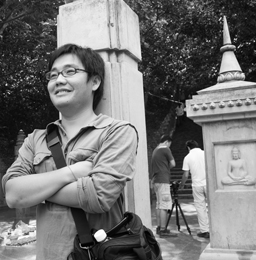Posted December 14th, 2010 at 7:51 am (UTC+7)
Bun Tharum, Phnom Penh
During a visit to Cambodia in November, US Secretary of State Hillary Clinton held a town hall meeting with 600 Cambodian youths. Of those in attendance at Chaktomuk Theater, along the riverside in Phnom Penh, 18 were allowed questions. And those questions were moderated by a 25-year-old Cambodian woman, Keo Kalyan, a holder of master’s degree in Public Administration from the Maxwell School of Citizenship and Public Affairs of Syracuse University in the US.

photo supplied by Keo Kalyan
Clinton, who stopped in Cambodia on a tour of Asia to bolster US diplomatic efforts in the region, praised Keo Kalyan for an excellent job moderating the meeting as an inspiration to many other younger Cambodians.
In an effort to find out more about Keo Kalyan’s personal experience as a townhall moderator, I contacted her for an email interview. She responded promptly, and the full interview is posted below.
How and why were you selected to take on the role as the moderator?
I received a call from the US embassy seeking my interest to become a moderator for a town hall meeting in honor of the visit of the US Secretary of State. At the moment, I was very excited, and without any pause I expressed my interest and immediately sent my CV to the embassy for their consideration. A few days later, I was called for an interview. The following day, I received a call informing me that I was selected as the moderator – some of the best news in my life.
How did you feel at the very moment you were offered the role?
I was very excited, overwhelmed, honored and proud, yet at the same time very nervous because it was going to be a huge task for me.
How much time did you have to prepare for the morning-long job?
On Friday evening, three days before the event started, I was called to meet with the special assistant to the Secretary, who was one of the people interviewing me. She briefed me about the event, the procedures and my roles. I was told that I would need to deliver brief introductory remarks before Secretary Clinton delivered her remarks. Thus, I spent my Saturday afternoon doing some homework and drafted my introductory remarks with my own ideas, and I rehearsed it several times at home. The next day, on Sunday afternoon, one day before the event, I went to Chaktomuk Hall for a rehearsal. Over there, I was able to feel the stage, the seats of participants, and I was briefed on key procedures and necessary logistics. I was well ready and came back home and got ready for the big event the next day.

photo supplied by Keo Kalyan
What impressed you most when you first met with Secretary Clinton?
What impressed me most when I first met with Secretary Clinton was her warm welcoming smile. To be honest, I was very nervous waiting for her arrival. My heart was beating faster and faster as I was being escorted to meet and greet her at the waiting room before Town Hall started. However, the moment she approached and shook my hands with a warm, welcoming smile, my nerves suddenly disappeared, and I felt her warm personality and kindness. She was asking me where I was born, where I studied and so on. I felt at east conversing with her. Despite her political role and status, despite her tiring travel and her busy schedule, she did not express those in her, yet she was smiling and kept me feeling so comfortable and easy standing next to her. She is truly an inspiring individual.
What’s your favorite moment or conversation you had with Secretary Clinton?
My favorite moment was that she started her remarks by appreciating my excellent job and looking into me. It was truly a defining moment for me to be appreciated by Secretary Clinton. All the effort that I had put into preparing myself to be a moderator was very rewarding. I was truly honored and grateful for this opportunity.
What did your parents and family members say about your job at the town hall when it was later broad-cast on the Cambodian Television Network?
My parents, family members and all my friends were so proud of me. They still keep praising me for the good job I did.
Having met with and accompanied a top US diplomat, were you inspired to pursue a diplomatic post in the near future?
Probably it is a bit too early for me to consider a diplomatic post in the near future. However, I have always been interested in exploring the world, exposing myself to an international environment, and traveling from one place to another. Whatever career I may be pursuing in the future, I will always want to be the confident, intellectual, influential and kind type like her. She is a role model that I will definitely look up to.
Kalyan Keo also maintains a blog at http://kalyankeo.blogspot.com/.




 Radio Podcasts
Radio Podcasts YouTube
YouTube Facebook
Facebook Twitter
Twitter Google+
Google+ Angkor One
Angkor One RSS
RSS Subscribe to Email Alerts
Subscribe to Email Alerts Mobile Version
Mobile Version